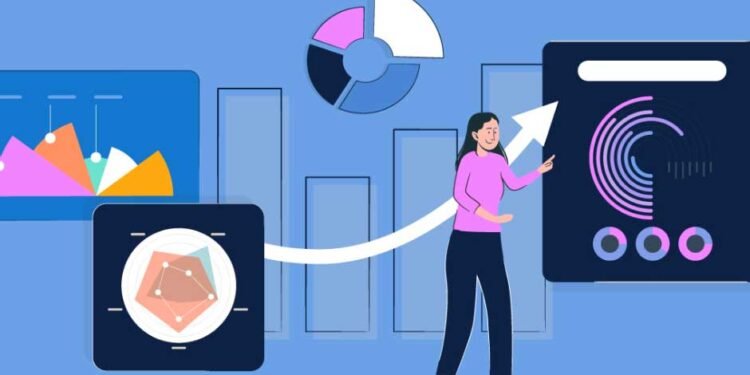In today’s data-driven landscape, effectively interpreting and communicating complex information is essential for business success. Data visualization is a critical tool that bridges the gap between raw data and actionable insights. By transforming intricate datasets into intuitive visuals, organizations can uncover patterns, trends, and relationships that might remain obscured.
Every type of data visualization has strengths well-suited for different business needs, ranging from simple charts to advanced interactive dashboards. By understanding these methods and how they can be used, businesses can effectively present data and empower stakeholders at all levels to quickly derive valuable insights. Engage with IT Outsourcing New Jersey to harness the power of data visualization for your business.
In this article, we will explore effective applications and methods of data visualization for businesses.
4 Methods of Data Visualization For Business
-
Charts and Graphs
Charts and graphs are essential data visualization methods. They provide a clear and concise way to present complex information. Charts, such as pie charts, bar charts, and line charts, effectively display numerical data in a visual format, making it easier for viewers to interpret trends and patterns.
Graphs, including scatter plots and histograms, offer a more detailed analysis of relationships between variables or distributions of data. By partnering with IT Support New York experts, businesses and researchers can communicate their findings effectively and make informed decisions based on the insights gained from the data.
-
Infographics
Infographics are a powerful data visualization method that presents complex information in a visually appealing and easy-to-understand format. By combining text, images, and graphics, infographics can effectively convey critical insights and data trends to a broad audience. They are handy for summarizing large datasets, highlighting relationships between variables, and making data-driven decisions.
When creating infographics, it is important to balance aesthetics and accuracy to ensure that the information is engaging and informative. By using infographics, organizations can communicate their data in a compelling and accessible way, driving better understanding and decision-making processes.
-
Dashboards
Dashboards are a critical component of data visualization methods, providing users with a comprehensive overview of critical metrics and KPIs in a visually appealing format. These interactive tools allow for the display of complex data sets in an easily understandable way, enabling stakeholders to grasp trends, patterns, and insights quickly.
Dashboards often feature various visual elements such as charts, graphs, and tables that can be customized to suit specific reporting needs. By utilizing dashboards effectively, organizations can streamline decision-making processes and drive business performance through data-driven insights.
-
Maps and Geographic Visualization
Maps and Geographic Visualization are potent tools in data visualization. By representing data spatially, maps can provide valuable insights into geographical patterns, relationships, and trends. They are handy for displaying information that is location-based or has a geographical component.
Geographic visualization techniques, such as choropleth maps, heat maps, and cartograms, allow for the effective communication of complex data sets visually compellingly. When used appropriately, maps can enhance understanding and decision-making across various fields, including business, public health, urban planning, and environmental studies.
4 Applications of Data Visualization In Business
-
Microsoft Power BI
Microsoft Power BI is an advanced data visualization application, facilitating the creation of interactive reports and dashboards. Its intuitive interface, coupled with its comprehensive features, empowers businesses to conduct meaningful data analysis and visualization.
Users can connect to various data sources, clean and transform data, and create visually appealing reports that provide valuable insights. Power BI offers advanced analytics capabilities such as predictive modeling and machine learning integration, making it a comprehensive tool for organizations looking to make informed decisions based on their data.
-
Google Data Studio
Google Data Studio is a powerful data visualization tool that allows users to create interactive dashboards and reports using various sources. With its user-friendly interface and customizable features, Google Data Studio enables businesses to analyze and present their data clearly and visually appealingly.
By connecting to sources such as Google Analytics, Google Ads, and other databases, users can easily pull in data to create insightful visualizations that help drive informed decision-making. Whether tracking website performance, monitoring campaign metrics, or presenting business insights to stakeholders, Google Data Studio is a valuable tool for transforming raw data into meaningful visual representations.
-
Adobe Illustrator / Adobe XD
Adobe Illustrator and Adobe XD are powerful tools for data visualization applications. Adobe Illustrator, known for its versatility in creating vector graphics, is often used to design detailed and intricate data visualizations. Its robust features allow users to create charts, graphs, and infographics with precision and creativity.
On the other hand, Adobe XD serves as an advanced user-experience design tool, ideal for prototyping interactive data visualizations. Its intuitive interface, coupled with seamless integration with other Adobe Creative Cloud applications, ensures a streamlined workflow for creating visually appealing and user-friendly data visualizations. Both software applications offer essential capabilities for professionals aiming to effectively communicate data insights through compelling visuals.
-
Excel / Google Sheets
Excel and Google Sheets are popular tools for data visualization applications due to their versatility and user-friendly interfaces. These spreadsheet programs offer various functions and features that allow users to create multiple visualizations, such as charts, graphs, and dashboards.
With Excel’s powerful data analysis tools and Google Sheets’ collaborative capabilities, both platforms provide an efficient way to organize and present data visually appealingly. Whether you are a beginner or an experienced data analyst, Excel and Google Sheets offer a solid foundation for creating insightful visual representations of your data.
Conclusion
Data visualization is an indispensable asset for businesses, offering a plethora of tools and techniques tailored to extract and convey critical insights from complex datasets. Interactive dashboards and advanced analytics tools facilitate the transformation of raw data into comprehensible, actionable intelligence. By adeptly employing these visualization strategies, organizations can significantly deepen their data comprehension, foster innovation, enhance operational efficiencies, and align with their strategic objectives in an increasingly data-centric world.












